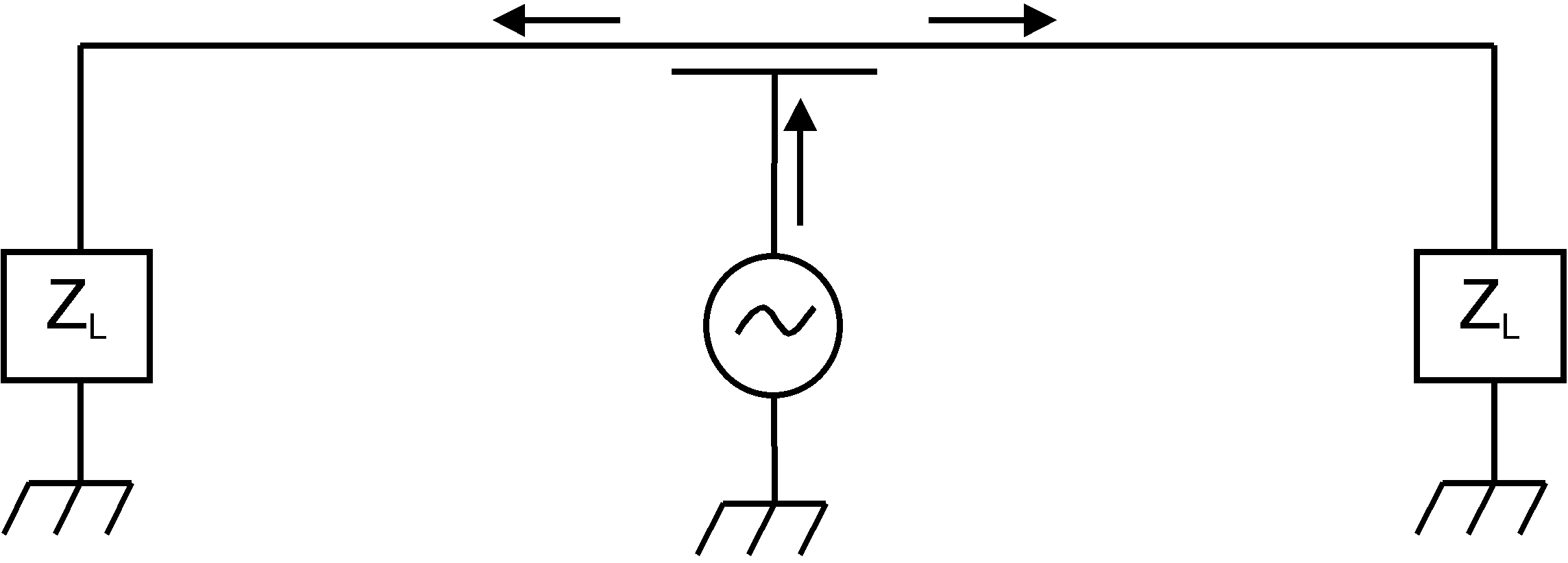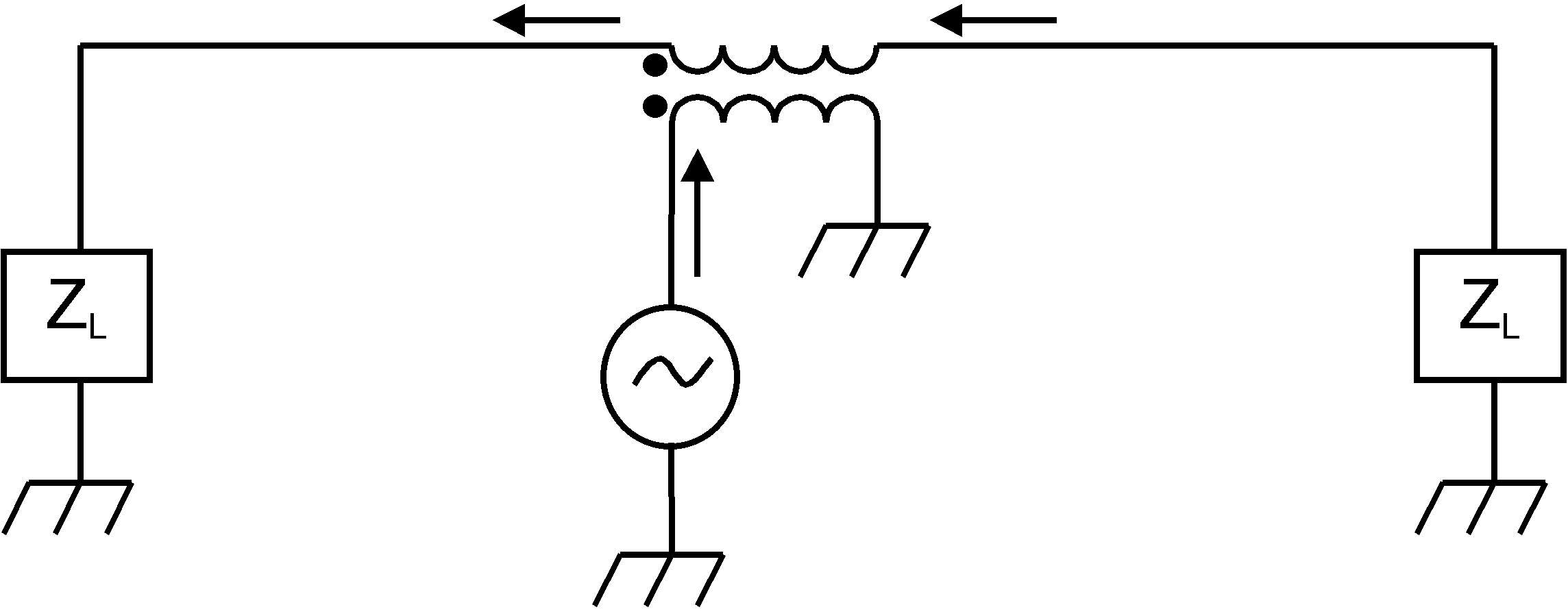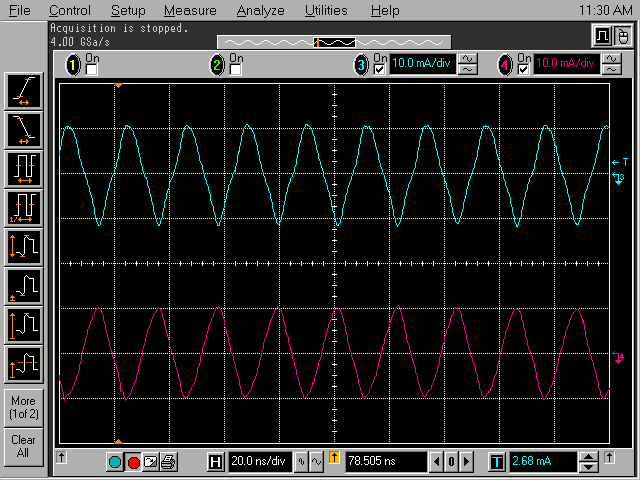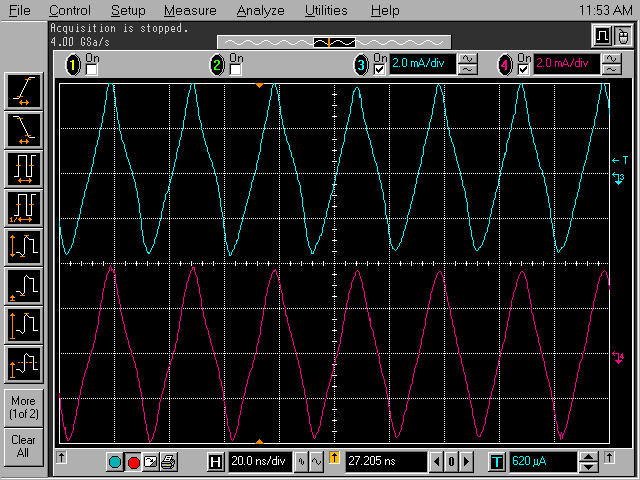
Figure 1. Capacitive Coupling Circuit
Abstract: Signals and noise coupled
onto conductors via capacitive or inductive mechanisms have different
characteristics that can be used to advantage in design and
troubleshooting. Both coupling modes are explored using circuit models and examples of uses are given.
Discussion: Figure 1 shows capacitive coupling from a source onto a conductor terminated in loads ZL. The injected signal is a current coupled across the capacitance resulting in current flowing in opposite directions on the conductor. For the purposes of this discussion we will assume that the dimensions of the coupling mechanism are a small fraction of a wavelength at the highest frequencies of interest so that time and phase delays may be ignored for simplicity. The two currents may be different if the circuit is not symmetrical about the coupling point (for example if the ZL loads are the not the same).
Current probes placed on the cable on opposite sides of the coupling point with the same orientation would display waveforms on a scope having inverted phase. If a ferrite core were placed to the right of the coupling point, the impedance inserted into the wire by the ferrite core would reduce the current to the right and in most cases, increase the current to the left. This effect can be used in troubleshooting equipment design problems and is covered in detail in my new seminar "Failure Analysis and Prevention in Electronic Circuits (Design Troubleshooting for the Lab and Field)."
Figure 2 shows the equivalent case for inductive coupling (mutual inductance). Instead of injecting a current that splits, as in capacitive coupling, a series voltage is induced in the coupled conductor that pushes a current along the conductor. In Figure 2, the source current entering the inductor at the "dot" side causes a voltage drop from left (+) to right (-). This induces a source voltage from left (+) to right (-) in the coupled conductor. The coupled voltage in the (secondary) conductor is the same polarity as the drop in the primary, but since it is a source instead of a drop, the current direction is reversed.
Note that the current is the same on both sides of the coupling point, even if the two loads are not equal and the circuit is not symmetrical (as long as the capacitive coupling between the inductors is negligible). If a ferrite core is placed on either side of the coupling point, the current will be reduced on both sides. With or without the ferrite core, a pair of current probes on each side of the coupling point will show the same current in the same direction. Although Figure 2 shows a "transformer," inductive coupling can sometimes take the form of two parallel conductors at frequencies of few MHz and higher.

Figure 2. Inductive Coupling Circuit
Most coupling I have encountered is either mostly capacitive or
inductive although there are significant cases where both types of
coupling come into play such as with SWR (standing wave ratio) bridges on RF transmission lines.
Figures 3 and 4 show capacitive coupled current and inductively coupled current, respectively, from the March 2002 and the February 2002 Technical Tidbits on this website. In those articles, it was shown that enough current can be coupled by either means from an IC onto a cable to potentially cause EMC emissions problems. The opposite phase of capacitively coupled current and the same phase of inductively coupled current are clearly seen in Figures 3 and 4.

Figure 3. Capacitively Coupled Current

Figure 4. Inductively Coupled Current
Summary: Capacitive and inductive coupling modes produce different current characteristics in the receiving circuit. The difference can affect how a design performs. Capacitive or inductive coupling can also be used for troubleshooting, allowing one to direct noise currents towards or away from a circuit port, for example.
Discussion: Figure 1 shows capacitive coupling from a source onto a conductor terminated in loads ZL. The injected signal is a current coupled across the capacitance resulting in current flowing in opposite directions on the conductor. For the purposes of this discussion we will assume that the dimensions of the coupling mechanism are a small fraction of a wavelength at the highest frequencies of interest so that time and phase delays may be ignored for simplicity. The two currents may be different if the circuit is not symmetrical about the coupling point (for example if the ZL loads are the not the same).
Current probes placed on the cable on opposite sides of the coupling point with the same orientation would display waveforms on a scope having inverted phase. If a ferrite core were placed to the right of the coupling point, the impedance inserted into the wire by the ferrite core would reduce the current to the right and in most cases, increase the current to the left. This effect can be used in troubleshooting equipment design problems and is covered in detail in my new seminar "Failure Analysis and Prevention in Electronic Circuits (Design Troubleshooting for the Lab and Field)."
Figure 2 shows the equivalent case for inductive coupling (mutual inductance). Instead of injecting a current that splits, as in capacitive coupling, a series voltage is induced in the coupled conductor that pushes a current along the conductor. In Figure 2, the source current entering the inductor at the "dot" side causes a voltage drop from left (+) to right (-). This induces a source voltage from left (+) to right (-) in the coupled conductor. The coupled voltage in the (secondary) conductor is the same polarity as the drop in the primary, but since it is a source instead of a drop, the current direction is reversed.
Note that the current is the same on both sides of the coupling point, even if the two loads are not equal and the circuit is not symmetrical (as long as the capacitive coupling between the inductors is negligible). If a ferrite core is placed on either side of the coupling point, the current will be reduced on both sides. With or without the ferrite core, a pair of current probes on each side of the coupling point will show the same current in the same direction. Although Figure 2 shows a "transformer," inductive coupling can sometimes take the form of two parallel conductors at frequencies of few MHz and higher.

Figure 2. Inductive Coupling Circuit
Figures 3 and 4 show capacitive coupled current and inductively coupled current, respectively, from the March 2002 and the February 2002 Technical Tidbits on this website. In those articles, it was shown that enough current can be coupled by either means from an IC onto a cable to potentially cause EMC emissions problems. The opposite phase of capacitively coupled current and the same phase of inductively coupled current are clearly seen in Figures 3 and 4.

Figure 3. Capacitively Coupled Current

Figure 4. Inductively Coupled Current
If the circuit is symmetrical (ZL
loads are the same and the rest of the circuit is a mirror image) then the
capacitively coupled currents will be equal on both sides. The capacitively and inductively coupled currents are then easily
separated from each other and measured with current probes. If a pair of matched current probes are
placed on the coupled conductor on each side of the coupling mechanism in the same orientation and their outputs are
subtracted (either in the scope or by reversing one probe and adding in
the scope), the inductive component will be canceled leaving only the
total capacitively coupled current displayed. If the output of the probes are
added, the capacitive component of currents will be canceled leaving
only the inductive components displayed (with 2X amplitude).
For the non-symmetrical case, the situation gets complicated. Inductive currents may flow in the capacitive coupling as well as along the wire between the loads so simple addition or subtraction of the current probes cannot be used to separate the components of the current.
For the non-symmetrical case, the situation gets complicated. Inductive currents may flow in the capacitive coupling as well as along the wire between the loads so simple addition or subtraction of the current probes cannot be used to separate the components of the current.
Summary: Capacitive and inductive coupling modes produce different current characteristics in the receiving circuit. The difference can affect how a design performs. Capacitive or inductive coupling can also be used for troubleshooting, allowing one to direct noise currents towards or away from a circuit port, for example.
Other articles on this website related to this topic are:
- February 2002, Cable Effects Part 2: Inductive Pickup by Cables in a System
- March 2002, Cable Effects Part 3: Capacitive Pickup by Cables in a System
If you like the information in this article and others on this website, much more information is available in my courses. Click here to see a listing of upcoming courses on design, measurement, and troubleshooting of chips, circuits, and systems.
Equipment used in this article includes:
Top of page
Home
